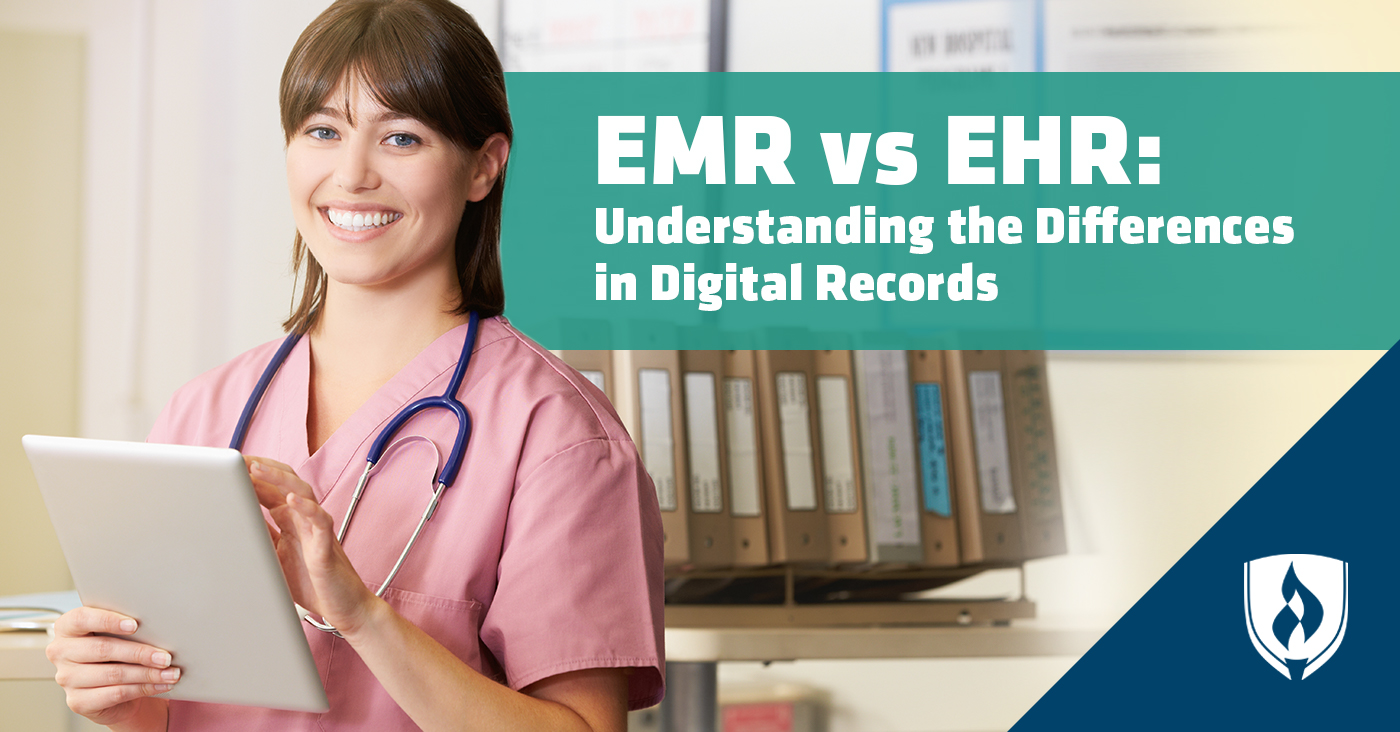
Now that you’re almost certain a career in healthcare is part of your future. Just like other industries, healthcare has evolved to live in the digital age. You’ll want to be sure you’re in touch with the latest trends and up-to-date on important new practices. Electronic medical records (EMR) and electronic health records (EHR) are huge buzzwords and understanding the differences between them is a step toward becoming a knowledgeable and relevant healthcare professional.
Let’s take a moment to answer the questions, “What is an EMR?” and “What is an EHR?” while also getting a peek into how they are already impacting the healthcare industry. By the time you’re done reading, you’ll be one step closer to becoming a healthcare professional who is future-forward and in-the-know.
What is an EMR?
EMRs are much like they sound—an electronic record or “chart” of the medical and clinical data gathered in a provider’s office. This chart could include diagnoses, medications, immunizations, allergies and more that a specific provider has encountered with their patient. An EMR typically stays within the practice where it was first created. For example, your medical doctor may have one EMR on you, your specialist may have another EMR on you and the hospital where you received emergency room care may have an entirely different EMR on you.
What is an EHR?
EHRs are similar to EMRs in that they are also an electronic record of a patient’s health history, diagnoses, medications and more. However, EHRs are “mobile” in the sense that they can travel electronically from clinic to clinic, provider to provider. This is referred to as health Information exchange, or HIE. Additionally, EHRs often contain a lot of technology that can help providers make decisions, avoid errors and collaborate with others.
EMR vs EHR: The advantages and disadvantages
At the onset, the two sound very similar, so what’s the big difference? Both EMRs and EHRs have some similar advantages and disadvantages, but you might find that one rises to the top.
The advantages
EHR: Information is mobile; providers can easily share information with other providers, specialists and more (HIE). This may improve collaboration.
EMR: Typically keeps a patient’s personal medical information within one provider’s system, which may help ensure patient privacy.
EHR: Clinical Decision Support tools (CDSs) can help a provider make decisions about patient care in a number of ways. These tools may alert a provider when there are possible drug interactions, allergies and other likely patient issues.
EHR: Computerized Physician Order Entry (CPOE) systems lets providers order drugs, lab tests, radiology, physical therapy and more. Ordering these types of tests electronically helps eliminate the possibility for error due to poor penmanship.
EMR: An EMR is still preferred over paper record, as all the information can be accessed quickly, updated seamlessly and saved without the risk of being physically lost or misunderstood due to poor penmanship.
The disadvantages
Both: Require start-up costs to cover hardware, software and employee training that can be significant.
Both: Run the risk of software malfunction and data loss.
EHR: Patient privacy may be a concern as electronic data is rarely 100 percent secure.
EMR: Information is not typically mobile/does not move from provider to provider etc., which can be a disadvantage if collaboration where to help a provider find a better care plan.
EHR: There has been a connection between increased medical errors due to poorly designed interface and/or lack of end-user training when it comes to CPOE.
How EHRs are already changing healthcare
If you haven’t picked up on it yet, there’s a pretty significant pull for EHRs that are happening in the healthcare sphere. Now that you have some of the potential pros and cons, you’re probably looking for the evidence. Take a moment to explore how EHRs are already leaving a big impact on healthcare.
A research article by Menachemi and Collum explored the different advantages and disadvantages of EHRs as revealed by research. There were three major areas that EHRs impacted positively and is worth taking a look at.
Clinical
Use of EHRs have been found to help increased adherence to evidence-based clinical guidelines. One example of this is that computerized reminders helped to increase vaccinations by 35 percent. Another use of EHRs is the prevention of redundancy or repeat testing in patients. Some studies found it to decrease redundant testing as much as 18, 24 and even 27 percent! This not only saves time and energy, but also resources as well. Finally, EHRs have also been shown to reduce some quite serious medication errors.
Organizational
Organizations can benefit from the use of EHRs in many ways. They have been shown to increase a healthcare organization’s revenue in a number of ways: Averting costs, improving billing and doing away with inefficiencies. Additionally, EHRs can also help organizations and physicians improve in meeting legal and regulatory standards, which helps cut down on malpractice claims.
Societal
Finally, society in general has been shown to reap the benefits of EHRs because of the availability of clinical data for research. This ability to research large amounts of data could lead to medical breakthroughs and better evidence-based practices that impact society at large.
Other trending healthcare topics to stay on top of
Now that you have answers to what an EMR and EHR is, you’re headed in the right direction. You’ve educated yourself on one major trend in healthcare, but there are so many other topics worth exploring. Stay informed throughout your studies by following Rasmussen College’s Health Sciences blog and check out our article, “Keeping Up with Technology in Healthcare: 10 HIT Blogs Worth Following,” for additional resources to follow.
RELATED ARTICLES:




